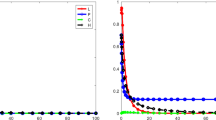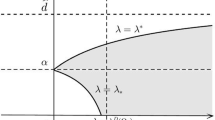Abstract
In this study, we examine the plant–herbivore discrete model of apple twig borer and grape vine interaction, with a particular emphasis on the extended weak-predator response to Holling type-II response. We explore the dynamical and qualitative analysis of this model and investigate the conditions for stability and bifurcation. Our study demonstrates the presence of the Neimark–Sacker bifurcation at the interior equilibrium and the transcritical bifurcation at the trivial equilibrium, both of which have biological feasibility. To avoid unpredictable outcomes due to bifurcation, we employ chaos control methods. Furthermore, to support our theoretical and mathematical findings, we develop numerical simulation techniques with examples. In summary, our research enhances the comprehension of the dynamics pertaining to interactions between plants and herbivores in the context of discrete-time population models.











Similar content being viewed by others
Data availability
This manuscript lacks any accompanying data.
References
Abbott KC, Dwyer G (2007) Food limitation and insect outbreaks: complex dynamics in plant–herbivore models. J Anim Ecol 76:1004–1014
Allen LJS, Strauss MJ, Thorvilson HG, Lipe WN (1991) A preliminary mathematical model of the apple twig borer (Coleoptera: Bostrichidae) and grapes on the Texas High Plains. Ecol Model 58:369–382
Allen LJS, Hannigan MK, Strauss MJ (1993) Mathematical analysis of a model for a plant-herbivore system. Bull Math Biol 55(4):847–864
Beiriger R, Thorvilson H, Lipe W, Rummel D (1988) The life history of the apple twig borer. Proc Texas Grape Growers Ass 12:101–106
Beiriger R, Thorvilson H, Lipe W, Rummel D (1989) Determination of adult apple twig borer sex based on a comparison of internal and external morphology. Southwest Entomol 14:199–203
Beiriger R (1988) The bionomics of Amphicerus bicaudatus (Say), the apple twig borer, on the Texas High Plains. MSc Thesis, Texas Tech University, Lubbock, Texas
Buckley YM, Rees M, Sheppard AW, Smyth MJ (2005) Stable coexistence of an invasive plant and biocontrol agent: a parameterized coupled plant–herbivore model. J Appl Ecol 42:70–79
Castillo-Chavez C, Feng Z, Huang W (2012) Global dynamics of a plant-herbivore model with toxin-determined functional response. SIAM J Appl Math 72(4):1002–1020
Cui Q, Zhang Q, Qiu Z, Hu Z (2016) Complex dynamics of a discrete-time predator-prey system with Holling IV functional response. Chaos Soliton Fract 87:158–171
Din Q (2015) Global behavior of a plant-herbivore model. Adv Differ Equ 2015:119
Din Q (2017) Complexity and chaos control in a discrete-time prey-predator model. Commun Nonlinear Sci Numer Simul 49:113–134
Din Q, Shabbir MS, Khan MA, Ahmad K (2019) Bifurcation analysis and chaos control for a plant–herbivore model with weak predator functional response. J Biol Dyn 13(1):481–501
Din Q, Shabbir MS, Khan MA (2022) A cubic autocatalator chemical reaction model with limit cycle analysis and consistency preserving discretization. Match 87:441–462
Din Q, Saleem N, Shabbir MS (2020) A class of discrete predator-prey interaction with bifurcation analysis and chaos control. Math Model Nat Phenomena
Edelstein-Keshet L (1986) Mathematical theory for plant-herbivore systems. J Math Biol 24:25–58
Feng Z, DeAngelis DL (2018) Mathematical models of plant-herbivore interactions. CRC Press, Boca Raton
Feng Z, Qiu Z, Liu R, DeAngelis DL (2011) Dynamics of a plant-herbivore-predator system with plant-toxicity. Math Biosci 229(2):190–204
Guckenheimer J, Holmes P (1983) Nonlinear oscillations, dynamical systems, and bifurcations of vector fields. Springer, New York
Gutierrez AP, Williams DW, Kido H (1985) A model of grape growth and development: the mathematical structure and biological considerations. Crop Sci 25:721–728
Jothi SS, Gunasekaran M (2015) Chaos and bifurcation analysis of plant-herbivore system with intra-specific competitions. Int J Adv Res 3(8):1359–1363
Kang Y, Armbruster D, Kuang Y (2008) Dynamics of a plant–herbivore model. J Biol Dyn 2(2):89–101
Kartal S (2016) Dynamics of a plant-herbivore model with differential-difference equations. Cogent Math 3(1):1136198
Khan AQ, Ma J, Xiao D (2016) Bifurcations of a two-dimensional discrete time plant–herbivore system. Commun Nonlinear Sci Numer Simul 39:185–198
Kuang Y, Huisman J, Elser JJ (2004) Stoichiometric plant-herbivore models and their interpretation. Math Biosci Eng 1(2):215–222
Kulenović MRS, Merino O (2002) Discrete dynamical systems and difference equations with mathematica. Chapman and Hall/CRC, New York
Kuznetsov YA (1997) Elements of applied bifurcation theory. Springer, New York
Li Y, Feng Z, Swihart R, Bryant J, Huntley H (2006) Modeling plant toxicity on plant–herbivore dynamics. J Dyn Differ Equ 18(4):1021–1024
Liebscher S (2015) Bifurcation without parameters, vol 526. Springer, Berlin
Liu X, Xiao D (2007) Complex dynamic behaviors of a discrete-time predator-prey system. Chaos Soliton Fract 32:80–94
Liu R, Feng Z, Zhu H, DeAngelis DL (2008) Bifurcation analysis of a plant–herbivore model with toxin–determined functional response. J Differ Equ 245:442–467
Loskutov AY (2001) Chaos and control in dynamical systems. Comput Math Model 12:314–352
Luo XS, Chen GR, Wang BH, Fang JQ (2003) Hybrid control of period-doubling bifurcation and chaos in discrete nonlinear dynamical systems. Chaos Soliton Fract 18(4):775–783
Lynch S (2007) Dynamical systems with applications using mathematica. Birkhauser, Boston
Ott E, Grebogi C, Yorke JA (1990) Controlling chaos. Phys Rev Letters 64(11):1196–1199
Pakes AG, Mailer RA (1990) Mathematical ecology of plant species competition. Cambridge University Press, Cambridge
Poincaré H (1885) Sur l’équilibre d’une masse fluide animée d’un mouvement de rotation. Bulletin Astronomique, Observatoire De Paris 2(1):109–118
Robinson C (1999) Dynamical systems: stability (symbolic dynamics and chaos). CRC Press, Boca Raton
Romeiras FJ, Grebogi C, Ott E, Dayawansa WP (1992) Controlling chaotic dynamical systems. Physica D 58:165–192
Schöll E, Schuster HG (2007) Handbook of chaos control. Wiley-VCH, Weinheim
Shabbir MS et al (2019) A dynamically consistent nonstandard finite difference scheme for a predator-prey model. Adv Difference Equ 2019:381
Shabbir MS, Din Q, Alabdan R, Tassaddiq A, Ahmad K (2020a) Dynamical complexity in a class of novel discrete-time predator-prey interaction with cannibalism. IEEE Access 8:100226–100240
Shabbir MS, Din Q, Ahmad K, Tassaddiq A, Soori AH, Khan MA (2020b) Stability, bifurcation and chaos control of a novel discrete-time model involving Allee effect and cannibalism. Adv Differ Equ 2020:379
Strogatz SH (1994) Nonlinear dynamics and chaos: with applications to physics, biology, chemistry and engineering. Adison-Wesley, Reading
Sui G, Fan M, Loladze I, Kuang Y (2007) The dynamics of a stoichiometric plant–herbivore model and its discrete analog. Math Biosci Eng 4(1):29–46
Tassaddiq A, Shabbir MS, Din Q, Ahmad K (2020) A ratio-dependent nonlinear predator-prey model with certain dynamical results. IEEE Access 2020:1
Tassaddiq A, Shabbir MS, Din Q (2022) Discretization, bifurcation and control for a class of predator-prey interaction. Fractal and Fractional 6(1):31
Tunç C (2010) A note on boundedness of solutions to a class of non-autonomous differential equations of second order. Applicable Analysis and Discrete Mathematics pp. 361–372
Tunç C (2013) Stability to vector Lienard equation with constant deviating argument. Nonlinear Dyn 73(3):1245–1251
Tunç C, Tunç O (2019) Qualitative analysis for a variable delay system of differential equations of second order. J Taibah Univ Sci 13(1):468–477
Wiggins S (2003) Introduction to applied nonlinear dynamical systems and chaos. Springer, New York
Yuan LG, Yang QG (2015) Bifurcation, invariant curve and hybrid control in a discrete-time predator-prey system. Appl Math Model 39(8):2345–2362
Zhao Y, Feng Z, Zheng Y, Cen X (2015) Existence of limit cycles and homoclinic bifurcation in a plant-herbivore model with toxin-determined functional response. J Differ Equ 258(8):2847–2872
Author information
Authors and Affiliations
Corresponding author
Ethics declarations
Conflict of interest
The authors hereby state that there exists no conflict of interest.
Additional information
Publisher's Note
Springer Nature remains neutral with regard to jurisdictional claims in published maps and institutional affiliations.
Rights and permissions
Springer Nature or its licensor (e.g. a society or other partner) holds exclusive rights to this article under a publishing agreement with the author(s) or other rightsholder(s); author self-archiving of the accepted manuscript version of this article is solely governed by the terms of such publishing agreement and applicable law.
About this article
Cite this article
Shabbir, M.S., Din, Q., De la Sen, M. et al. Exploring dynamics of plant–herbivore interactions: bifurcation analysis and chaos control with Holling type-II functional response. J. Math. Biol. 88, 8 (2024). https://doi.org/10.1007/s00285-023-02020-5
Received:
Revised:
Accepted:
Published:
DOI: https://doi.org/10.1007/s00285-023-02020-5




